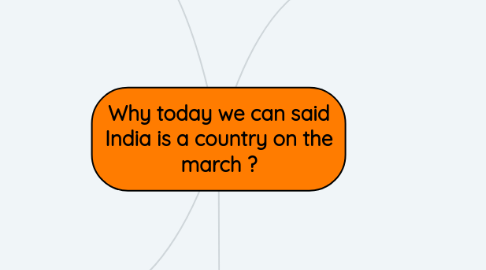
1. India :mystic and ancient land
1.1. thousands years of civilization
1.1.1. Religions
1.1.1.1. Hinduism
1.1.1.1.1. Brahma
1.1.1.1.2. Vishnu
1.1.1.1.3. Shiva
1.1.1.1.4. Diwali
1.1.1.2. Islam
1.1.2. Monuments
1.1.2.1. city palace of jaipur
1.1.2.2. Taj Mahal
1.1.2.3. Ganga
1.1.3. Philosophy
1.1.3.1. Yoga
1.1.3.1.1. Ashram
1.1.3.2. Ayurveda
1.1.3.3. ancient custom
2. India, a future superpower ?
2.1. devlopment since a century
2.1.1. BRICS
2.1.1.1. GDP
2.1.1.1.1. + 90% in 50 years
2.1.2. Population
2.1.2.1. 1.349.707.000
2.1.2.2. Mumbaï 3rd densest city on earth
2.2. tourism
2.2.1. 5 millions visitors / years
2.2.2. Incredible India project
2.2.2.1. 16% increase in tourists traffic
2.2.3. New type of tourism
2.2.3.1. Sophisticated travellers
3. Idea of progress
4. "traditional India": An underdeveloped country
4.1. Inequality
4.1.1. women rights
4.1.1.1. Child mariages
4.1.2. Child labour
4.1.2.1. Low cost production
4.2. poverty
4.2.1. Lack of water
4.2.2. ineffective system of education
4.2.3. Deep poverty
4.2.4. Malnutrition
4.3. castes
4.3.1. Brahmins
4.3.2. Kshatryas
4.3.3. Vaishyas
4.3.4. Shudras
4.3.5. Untouchables
5. The new face of India : A modern country
5.1. Culture
5.1.1. Lifestyle
5.1.1.1. westernization
5.1.1.1.1. Way of consumption
5.1.1.1.2. Bollywood
5.1.2. Philosophy
5.1.2.1. Personal identity
5.1.2.1.1. Social network
5.1.2.2. Microfinance
5.1.2.2.1. Extricate from poverty
5.1.2.3. Ghandi
5.1.2.3.1. Fight for peace and rights
5.2. IT technologies
5.2.1. Karnataka
5.2.1.1. Bengalore
5.2.2. India's coding farm
5.2.3. Cutting edge of techologies
5.2.4. New contester
5.3. U-turn
5.3.1. Economic
5.3.1.1. workshop of the world
5.3.1.2. Chinese model
6. Conclusion
6.1. India before
6.1.1. Traditional India
6.1.1.1. Cultural heritage
6.1.1.1.1. Monuments
6.1.1.1.2. Custom
6.1.1.1.3. Religions
6.1.1.1.4. Castes
6.1.1.2. Closed minds
6.2. How India has changed
6.2.1. Devlopment
6.2.1.1. Population
6.2.1.2. Tourism
6.2.1.3. U-turn
6.2.1.3.1. Cultural
6.2.1.3.2. Economic
6.3. India now
6.3.1. Modern
6.3.1.1. Culture
6.3.1.1.1. Lifestyle
6.3.1.1.2. Way of thinking
6.3.1.2. Technologies
6.3.2. Faulty side
6.3.2.1. Inequality
6.3.2.2. Poverty
